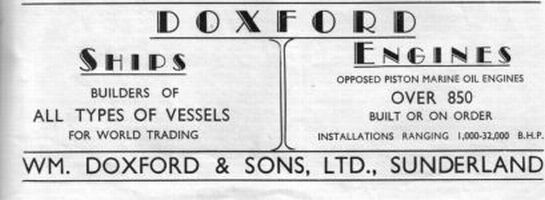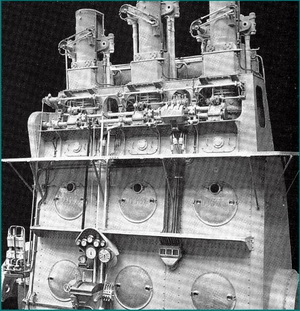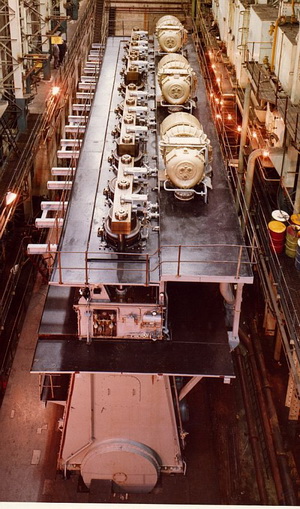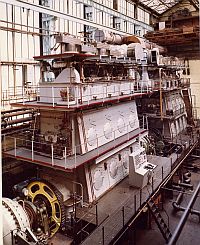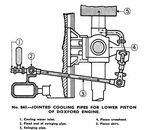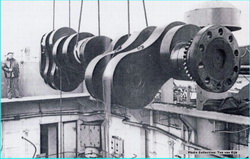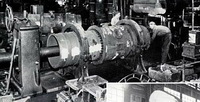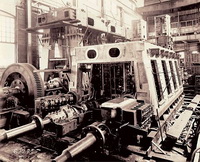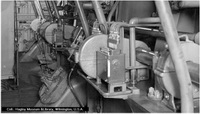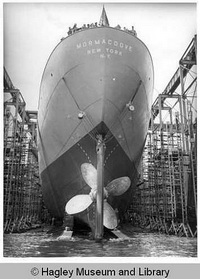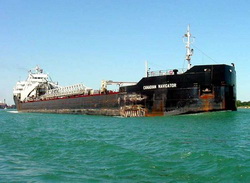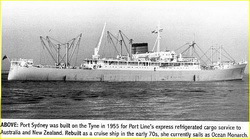Content of the Doxford area...
History Types The "Works" Drawings Damages In the USA On Film About this area Original Doxford Site Main Historical MMEP - Home Short history of William Doxford & Sons...
1840 - at Cox Green in England, William Doxford starts to build wooden ships.
1857 - William Doxford moved to Pallion (Sunderland), where he began operation on a much larger scale.
1870 - a larger site was purchased, and five new berths were laid down.
1878 - William Doxford and Sons began building marine steam engines and steam boilers in.
1902 - the original five berths were scrapped to make room for three berths, of greater length and breadth, which enabled the firm to build vessels up to 540 feet in length, and of 20,000 tons capacity.
1906 - Doxford begins to consider the possibilities of the diesel motor for ship propulsion. When WWI ends, they resumed work on the four-cylinder engine, and after further research and the completion of successful trials, it was felt justified in putting this into production.
1921 - the engine was installed in the Swedish ship, Yngaren', this was the first motor ship to be built by Doxford. From that day, the name of Doxfords became world famous. A total of �100,000 had been spent on developing this new engine. A further five units were built during the 1920-23 depression.
Doxfords continued with research and development, overcoming problems of vibration. Then during the grim thirties' when hardly a keel was laid in Sunderland yards, important changes took place in the design and construction methods of the engines. Using steel welded fabrications of the superstructures and supporting frames obtained substantial size and weight reduction.
Cast-iron bedplates were still in use until 1936 when fabricated construction was extended to these also During World War II they turned their whole production over to a three-cylinder 2,500 bhp unit. It later earned the title of the economical'; because of its low fuel consumption, only six tons a day. Ships with heavy loads had to run this engine at or near to its limiting rpm to keep up with a convoy in the North Atlantic.
Dr. Griffiths summarizes the historical timeline of the Doxford Engine. Here is another good historical article, on the Doxford, more generalized though. And ou can read even more about the History of Doxford & Sons, here.
The types of diesel engines that Doxford & Sons made
“L / LB / LBD” Type
Long
Long Balanced
Long Balanced with Diaphragm“P” Type
...as a tribute to Percy Jackson
Percy Jackson was a leading British engineer who helped designed the Doxford Oppose piston engines. You can read about him, and his careers, here, and here.
“J” Type
... once again, named as a tribute to Percy Jackson
You can download the introduction section of the service manual here, which explains the concept and workings of a Doxford J Type.
"J Engine" pictured on test bedThe Doxford Seahorse was the result of a joint venture with Hawthorn Leslies. It was developed as a medium speed engine for land based and marine applications. The engine was much smaller than the 'J' engine, smaller bore, shorter combined stroke but developing the same power/cyl as the 'J' type. Designs available would be 4-7 cylinders, developing 10K-17.5K BHP. It never made production, but various features from the Seahorse were included in the last Doxford design the 58JS. See a video of it here.
Doxfords in pictures...
Take a fantastic pictorial tour of the Doxford Factory, circa 1958. A fascinating look at the men and the equipment that built these massive machines. Technical drawings of various components from the Doxford diesel engine. Damages. Sometimes, things break, in this gallery you'll find damaged parts from various Doxford engines.
Doxfords in the United States...
DOXFORD Engines were also built by SHIPBUILDING & DRY DOCK Co, of Chester, Pennsylvania, U.S.A.
Sun Shipbuilding & Dry Dock Company (Sun Ship) was developed by Sun Oil in 1917 as a tanker builder and was in continuous operation throughout the lean inter-war years. At the beginning of the WWII emergency, its 8 ways were increased to 20 with $28mm from the USMC, and later to 28, making it the single largest shipyard in the country.
At its peak it employed more than 40,000 people, organized in four adjacent yards. The most northerly of the four, known as the #4 Yard, was manned almost exclusively by African-American workers.
After the war, the South Yard and the #4 Yard were sold for industrial development and Sun continued as a merchant shipbuilder in the Central and North Yards. It was sold to Pennsylvania Shipbuilding (Penn Ship) in 1982, class "special" but closed in 1989. The North Yard is now Penn Terminals, a very successful independent cargo terminal, the only U.S. port facility that employs Boilermaker labour.
The Central Yard site has been sold or leased for multiple uses: the south end is now part of neighbouring Kimberly-Clark (formerly Scott Paper), the parking lot to the east of Morton Avenue is now a state penitentiary and the big floating dry-dock is now in Galveston. The remainder of the Central Yard is now Harrah's Chester Casino & Racetrack.
See the shipyard from the air, on Google, here. You can still see the old WWII building ways in what used to be the South and #4 Yards.
Here, you can download a marketing brochure about Sun Ship; and here is a description and list of Sun Oil's Marine Department fleet.
You can find additional information on Sun Ship, at these external link
Sun Ship Historical Society's Website
SUN-DOXFORD Engine Works Left: Boring out Cylinder liner
Right: Crankshaft machineMV Texas Sun
1937-1960,
Yard no: 159
SUN-DOXFORD 640LB5, 5600 BHPTop View pictured
MV Sialia
Owner: Henry Ford (Ford Motor Company)
Date: 6.10.1925.
Twin Bank Doxford. Each four cylinder crankshaft droves its own propeller; 13" bore, 22" and 19" stroke.
750BHP per shaft at 200rpm,
bmep 72lbs sq.inch. Firing Order 1,3,4,2. Columns and entablature cast aluminum alloy.MV Donald MacKay
1939-1974
Yard no: 175
SUN-DOXFORD 815LB4, 600BHPAft Camshaft and Top View pictured
MV MorMacDove 1939-1973
Yard no: 178
SUN-DOXFORD 813LB4, 6000BHP
Pictured: MorMacDove in Drydock; and "man stand" on MV Donald McKay
Doxfords on film...
larger picture29-11-1953 launched and 1/1953 completed at WILTON-FIJENOORD(Yard no:734), Schiedam, Holland for "St� Fran�aise de Transports P�troliers", Dunkirk
DOXFORD Oil Engine of 7750 BHP, 6 Cylinder 2S.C.SA
larger pictureBuilt in Great Britain as the Demeterton, and went into salt water duty. Over the years, she received several upgrades that increased both her length and cargo capacity. She was sold in 1975 to Upper Lakes Group, and moved over to Great Lakes service. Several name changes followed; she became the Canadian Navigator in 1980.
DOXFORD: 76JT4, 9680 BHP
larger pictureM.V. North Sands The 64,500 ton tanker is pictured here, leaving River Wear 1965. The cost per BHP is closely related to the specific weight.
Nine cylinder 20,000BHP J type Doxford
larger pictureBuilt as "Port Sydney" by "Swan Hunter & Wigham Richardson", Newcastle upon Tyne, 1955. Former names 1955-1972: Port Sydney, 1972-1975: Akrotiri Express, Greece, 1975-1997 Daphne, 1977-2002 Switzerland, 2002 up till now: Ocean Monarch.
Two 6 cylinder Doxford's, 12,200 BHP.
larger pictureMV Pioneer Built as “Canadian Pioneer” Launch date: 16/5/1981
37448 Ton Bulkcarrier, built at the Port Weller Docks in St. Catherines, Ontario, Canada.DOXFORD: Type: 760J4CR, 9000 BHP, Year1980 (Still on duty 2010) The last engine built at Doxford.
See also Self Unloading System.
MV Princess Daphne, ex Port Sidney - Twin Doxford powered passenger ship on its last voyage to the ship breakers.
About this area...
This area, exploring Doxford engines, was originally created by Alfons Verheijden, a retired Chief Engineer, in the Dutch Merchant Navy. His original website featuring this material can be found here. He writes...
" In the sixties I was 15 months as 2nd Engineer on a ship with a Doxford Engine; a 5 cylinder LB engine. Later on, I was 9 month Chief Engineer on another ship, with a 6 cylinder Doxford engine also from the LB type. The ship's name were resp. mv Kieldrecht and mv Loosdrecht from the Dutch owner Phs. van Ommeren, of Rotterdam. Both were general cargo ships with many days in Port, so we had plenty time for maintenance. I was always an admirer from the famous Doxford Engine, but as you wrote, it is all historical now. The last one are still in service, but there are no more new Doxford's built nowadays! "
You can send Chief Verheijden an email here. You can see many more Doxford pictures on his Flickr's Page. You can read an article he wrote for the Doxford and Friends newsletter, here.
Chief Verheijden has also compiled various lists...
Seeing how an important historical resource for marine engineer, might one day disappear - because it was hosted on his personal ISP web space - he was contacted by Martin's Marine Engineering Page, to see if his website and resources might be represented in this space. The results are found in this area of www.dieselduck.net, and we are very pleased to offer his work online.
If you have marine engineering resources, and have dedicated much time and energy in developing it, only to have it vanish after some time online; why not consider letting us host it. Save and share it online, for all our peers to experience. We have ample, stable, web server space, and would love to showcase your work. Martin's Marine Engineering Page has been online since 1999. Contact us for more information.
Additional Doxford reference on the web...
Content of the Doxford area...
History Types The "Works" Drawings Damages In the USA On Film About this area Original Doxford Site Main Historical MMEP - Home Top Brought to you by www.dieselduck.net, comments to [email protected]

